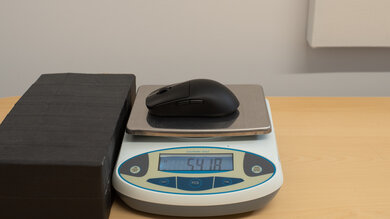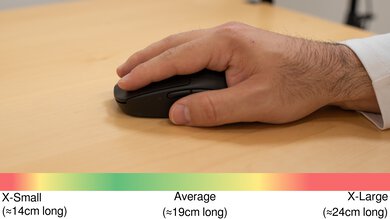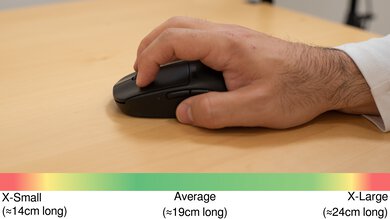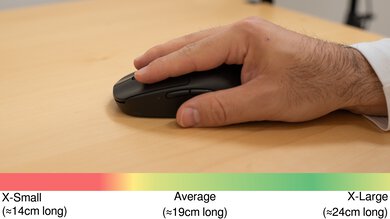The Pulsar X2V2 continues Pulsar's X2 lineup of lightweight symmetrical gaming mice. It shares the same shape and sensor as the previous generation Pulsar X2, with some subtle design changes, including side buttons that are closer together and a top shell with integrated side panels. It features several improvements over the previous generation, like new optical switches, a new scroll wheel encoder, and improved construction that feels noticeably more rigid. It's also compatible with Pulsar's 4K Dongle, which can increase its maximum wireless polling rate to 4000Hz, but it's sold separately.
Several other new models in Pulsar's X2 lineup share the same internals as the X2V2, which we've discussed in the Differences Between Variants section.
Our Verdict
The Pulsar X2V2 is decent for work use despite not being designed specifically for it. It has excellent build quality, and you can easily remap buttons using the companion software. It connects wirelessly with its USB receiver but doesn't support Bluetooth connectivity or multi-device pairing. Also, its scroll wheel lacks a free scrolling mode and L/R tilt inputs.
-
Symmetrical shape is comfortable for most hand sizes and grip types.
-
Excellent build quality.
-
No Bluetooth connectivity or multi-device pairing.
-
Scroll wheel lacks L/R tilt inputs and free-scrolling.
-
Lightweight bottom plate design means the inside is open to dust and debris.
The Pulsar X2V2 is an outstanding mouse for FPS gaming. It's extremely lightweight, making it very easy to move around quickly and accurately. It has remarkable overall performance too, with extremely low click and sensor latency for a precise and responsive gaming experience. It also feels very well built and has an accommodating symmetrical shape with mouse feet that glide smoothly across mousepads and desks.
-
Symmetrical shape is comfortable for most hand sizes and grip types.
-
Extremely lightweight.
-
Outstanding click latency.
-
Excellent sensor latency and accuracy.
-
Lightweight bottom plate design means the inside is open to dust and debris.
The Pulsar X2V2 is a good mouse for MMO gaming. It doesn't have as many additional buttons as a dedicated MMO mouse, but you can still easily reprogram its buttons using the companion software. It has a comfortable symmetrical shape with excellent build quality, so it's well-suited for long gaming sessions. It also has outstanding raw performance that delivers an accurate and responsive-feeling gaming experience.
-
Symmetrical shape is comfortable for most hand sizes and grip types.
-
Excellent build quality.
-
Outstanding click latency.
-
Not as many buttons as dedicated MMO gaming mice.
-
Lightweight bottom plate design means the inside is open to dust and debris.
The Pulsar X2V2 has outstanding raw performance overall. It has remarkably low click and sensor latency and reacts accurately and consistently to your inputs.
-
Outstanding click latency.
-
Excellent sensor latency and accuracy.
- 7.2 Work
- 9.2 Video Games (FPS)
- 7.9 Video Games (MMO)
- 9.4 Raw Performance
Changelog
-
Updated May 08, 2025:
We've added a link to the newly reviewed MCHOSE L7 Pro in the Sensor Specifications section of the review.
-
Updated Nov 29, 2024:
We've added a link to the newly reviewed Pulsar X2H v3 in the Hand Size Recommendation section of the review.
-
Updated Oct 21, 2024:
We've added a link to the newly-reviewed VGN Dragonfly F1 Pro Max in the Build Quality section of this review.
- Updated May 24, 2024: We've added a link to the newly reviewed Ninjutso Sora V2 in the Weight section of this review.
- Updated Jan 22, 2024: We've added a link to the newly reviewed Corsair M75 AIR in the Hand Size Recommendation section of this review.
Check Price
Differences Between Sizes And Variants
The Pulsar X2V2 is available in black and white colorways. We bought and tested the black X2V2. You can see the label for our unit here.
Several other variants exist in Pulsar's X2 lineup. These include the The X2V2 Mini, X2H, X2H Mini, X2A, and X2A Mini. We expect the tests in our review to broadly apply to these versions, as they all share the same internals. In the table below, we've included details regarding the differences between models in Pulsar's new X2 lineup.
| Name | Size | Colorways | Notes |
|---|---|---|---|
|
X2V2 |
Medium | Black, White | Standard shape |
| X2V2 Mini | Small | Black, White | Standard shape, smaller size |
| X2H | Medium | Black, White | Higher hump that's positioned towards the back |
| X2H Mini | Small | Black, White | Higher hump that's positioned towards the back, smaller size |
| X2A | Medium | Black, White | Fully ambidextrous with two additional buttons on the right side |
| X2A Mini | Small | Black, White | Fully ambidextrous with two additional buttons on the right side, smaller size |
If you have or come across a variant not represented on this table, reach out to us in the discussions at the end of this review.
Compared To Other Mice
The Pulsar X2V2 is the successor to the Pulsar X2. It's an extremely lightweight gaming mouse with a symmetrical shape that is identical to the previous version. It has an improved construction that feels noticeably more rigid. It also has a new scroll wheel encoder and uses optical switches for its left- and right-click buttons.
Like its predecessor, this mouse offers performance that rivals the wireless, symmetrically-shaped flagship models from larger brands like Razer and Logitech, including the Razer Viper V2 Pro and the Logitech G PRO X SUPERLIGHT 2. Unlike those mice, the X2V2 features an open bottom design that helps reduce its weight but also leaves the internals prone to collecting dust and debris. Also, this mouse's implementation of optical switches may not feel as snappy and satisfying as other flagship mice.
For more recommendations, see our picks for the best FPS mouse, the best gaming mouse, and the best lightweight mouse.
The Pulsar X2V2 and the Pulsar X2 are lightweight wireless gaming mice in the same lineup. The X2V2 is newer and features an updated build that feels slightly higher quality. It also uses optical switches for its left- and right-click buttons, and it supports a 4000Hz polling rate by purchasing a separate dongle. The X2 is older, uses mechanical left- and right-click switches, and is heavier by a very small margin.
The Pulsar X2V2 and the LAMZU Atlantis are lightweight wireless gaming mice with similar symmetrical shapes. The Pulsar is smaller than the LAMZU, with a slightly more substantial hump toward the back of the mouse. The Pulsar has better build quality and performs better than the LAMZU, with better click latency, sensor latency, and sensor accuracy.
The Razer Viper V3 Pro and the Pulsar X2V2 are lightweight, high-performance wireless gaming mice with symmetrical shapes. They weigh about the same, but the Pulsar has an open bottom plate design that leaves its inside open to dust and debris. While they both perform remarkably well, the Razer has a higher maximum polling rate of 8000Hz and slightly lower click and sensor latency than the Pulsar.
The Logitech G PRO X SUPERLIGHT 2 and the Pulsar X2V2 are high-performance wireless gaming mice with symmetrical shapes. The Pulsar is slightly smaller, and it has a steeper hump that's closer to the back of the mouse, whereas the Logitech has a more egg-like shape. The Logitech supports a polling rate of 8000Hz natively, while the Pulsar supports a polling rate of up to 4000Hz, but only with the purchase of an additional wireless receiver.
The Pulsar X2H v3 and the Pulsar X2V2 are lightweight wireless gaming mice from the same lineup. The X2V2 has a flatter shape that's well suited for all grip types, whereas the X2H v3 has a higher rear hump and a cinched midsection that's optimized specifically for claw grip. The X2V2 has slightly better sensor performance, but it's not noticeable in-game.
The Pulsar X2V2 and Pulsar X3 are wireless gaming mice with similar performance and nearly identical weights. The main difference is their shape: The X2V2 has a symmetrical shape best suited for claw or fingertip grips, while the X3 features a right-handed "ergo" shape with a pronounced hump and broad rear, making it well-suited for palm or claw grips. The X3 also uses a slightly newer sensor, but this provides only marginal benefits, like tracking on transparent glass and slightly better stability at higher polling rates.
The Pulsar X2V2 and the MCHOSE L7 Pro are lightweight wireless gaming mice with nearly identical shapes, but the MCHOSE is smaller and lighter overall. It also has a fully enclosed body, whereas the Pulsar has an open bottom plate design. The two deliver similar raw performance, but the MCHOSE supports an 8000Hz polling rate out of the box. Otherwise, the Pulsar has better build quality and better mouse skates.
The Ninjutso Sora V2 and the Pulsar X2V2 are lightweight, high-performance gaming mice with symmetrical shapes. The Ninjutso is significantly lighter than the Pulsar despite having a completely solid plastic shell. The two perform similarly, but the Ninjutso has lower sensor latency than the Pulsar. Also, while the two have 1000Hz maximum polling rates out of the box, they're compatible with higher polling rates of 4000Hz and 8000Hz with the purchase of an additional wireless receiver for the Pulsar and the Ninjutso, respectively. The Ninjutso's additional dongle has yet to come on sale.
The LAMZU Atlantis Mini 4K and the Pulsar X2V2 are lightweight, high-performance wireless gaming mice with symmetrical shapes. The LAMZU is slightly smaller but has a wider rear end, whereas the Pulsar has a straighter shape across the sides. The LAMZU natively supports a 4000Hz polling rate and has better click latency and sensor performance than the Pulsar. On the other hand, the Pulsar has better build quality.
The Pulsar X2V2 and the Razer Viper V2 Pro are high-performance wireless gaming mice with symmetrical shapes. The Razer has a smaller hump that's positioned towards the middle of the mouse, whereas the Pulsar's hump is positioned towards the rear of the mouse. The Pulsar weighs marginally less, but it has an open bottom design. Also, the Razer supports a maximum polling rate of 8000Hz with the purchase of an additional receiver, and the Pulsar supports a lower maximum polling rate of 4000Hz with the purchase of their 4k dongle.
The Pulsar X2V2 and the VGN Dragonfly F1 Pro Max are lightweight wireless gaming mice with symmetrical shapes. The Pulsar has a hump that's further towards the rear, whereas the VGN has a more centered hump, making the Pulsar more supportive for claw grip. The two mice trade blows in terms of performance, but they're still superb overall.
The MCHOSE L7 Ultra and the Pulsar X2V2 are lightweight wireless gaming mice with similar symmetrical shapes with rearward humps, best suited for claw or fingertip grips if you have small or medium-sized hands. The Pulsar is a little larger and has better build quality and mouse feet. Comparatively, the MCHOSE is slightly smaller and lighter and has slightly better raw performance. It also supports Bluetooth, a feature the Pulsar lacks.
Test Results
This mouse is almost identical to the previous Pulsar X2, with a simple, minimal design and a matte black finish. It retains the familiar baseplate design that exposes the inside of the mouse as well. The main differences are that this mouse's top shell is one piece instead of having side panels, and the side buttons are closer together. Also, the logo below the left click is printed on rather than engraved.
There's a variant of this mouse called the Pulsar X2A with side buttons on both sides for left- or right-handed users. See the Differences Between Variants section for more information.
This mouse isn't designed specifically for portability. It's bulky and lacks an internal compartment for storing the USB receiver. Also, its open-bottomed design leaves the interior more prone to damage during transport than a mouse with a solid baseplate.
The Pulsar X2V2 has excellent build quality that's slightly better than the previous generation Pulsar X2. It has a plastic body with a matte black finish that feels comfortable in your hand. There isn't any noticeable flex in the body, even if you apply considerable pressure.
If you're looking for a mouse with a similar weight but has a traditional closed bottom plate, check out the VGN Dragonfly F1 Pro Max.
This mouse is extremely lightweight, making it very easy to move accurately and quickly.
There's also a smaller version of this mouse called the Pulsar X2V2 Mini, which Pulsar indicates is about 2g lighter.
If you're looking for a mouse that weighs even less and has a completely solid outer shell, check out the Ninjutso Sora V2.
This mouse has an identical shape to the Pulsar X2. It's a medium-sized mouse with a hump in the middle and a slightly wide rear end that comfortably fills out your palm. The side buttons are well-placed and easily reachable for most hand sizes and grip types. Still, the overall shape is best suited for a claw or fingertip grip.
There's also a smaller version of this mouse called the Pulsar X2V2 Mini, which is better suited for smaller hands. See the Differences Between Variants section for more information.
The Pulsar X2H v3 has a similar shape but with a taller rear hump that provides more support for claw grip.
If you're looking for an option with a larger symmetrical shape, check out the Corsair M75 AIR.
You can connect to this mouse wirelessly with its included 2.4 GHz USB receiver. Pulsar also offers a 4k Dongle, which allows you to increase the polling rate up to 4000Hz, but it's sold separately. It has a rechargeable battery that Pulsar claims has up to 100 hours of battery life. Pulsar also claims that the battery level indicator in the companion software is more accurate than that of the previous generation Pulsar X2. A small LED next to the front side button will blink red when the battery is low. If you're looking for a mouse that supports a 4000Hz polling rate natively, check out the LAMZU Atlantis Mini 4K.
The Pulsar X2V2 has a paracord-like charging cable that's lightweight and flexible. It easily glides across desks and mousepads with minimal drag. However, it retains some permanent kinks from its packaging.
This mouse has feet that glide remarkably smoothly across mousepads and desks. The feet have mostly rounded corners, but there are two sharp corners on the top foot. There's a slight scratching sound when gliding on a mousepad, but this doesn't impact gliding performance. Third-party replacement feet are also available.
The left- and right-click buttons use optical switches, which is a new addition to the X2 lineup. There's a small tactile bump during pre-travel, which very likely won't be noticeable during normal use. Still, it's noticeable if you try to ride the actuation point, and it could be irritating if you prefer a more consistent linear switch travel feeling.
You can program all of the buttons on this mouse except for the scroll up/down inputs and the CPI button on the underside.
The Pulsar X2V2 has outstanding click latency. It provides an extremely responsive-feeling experience suitable for casual and competitive play. We conducted this test at the mouse's native polling rate of 1000Hz and at the lowest debounce setting of 0ms.
We also tested this mouse at 4000Hz using Pulsar's 4K Dongle, which they sell separately. We found the results to be even better at an impressive 1.7 ms. Here is the graph of our results, and here is video.
This mouse has remarkable CPI performance. It tracks your movements precisely and accurately with little variation. We conducted this test at the mouse's native polling rate of 1000Hz.
The Pulsar X2V2 has excellent sensor latency performance. It reacts very quickly to your inputs, and you won't notice any delay. We conducted this test at the maximum native polling rate of 1000Hz with Motion Sync turned off.
We also tested this mouse with Motion Sync turned on and at 4000Hz using Pulsar's 4k Dongle, which they sell separately. You can see graphs for our results with the following settings:
This mouse's native polling rate options are 125Hz, 250Hz, 500Hz, and 1000Hz. Like other mice using PixArt's PAW3395 sensor, this mouse features Motion Sync, a toggleable sensor setting that synchronizes sensor data with polling events. It can improve how closely your mouse movements are matched on-screen, but can add around 1 ms of motion latency. Pulsar also sells a 4K Dongle, which allows you to increase the polling rate to 4000Hz.
If you're looking for a mouse that supports an 8000Hz polling rate right out of the box, check out the MCHOSE L7 Pro.
The Pulsar X2V2 has a grippy scroll wheel with a grooved rubber finish for grip. It uses Pulsar's new Blue Encoder, which operates precisely and quietly with pronounced yet smooth step definition.
The buttons and the scroll wheel on this mouse are quiet and won't bother those around you.
This mouse uses Pulsar Fusion software, which is well-laid out and user-friendly. It doesn't feel as bloated as software options from larger mouse manufacturers and lets you adjust all the expected options, including polling rate, CPI, lift-off distance, debounce time, sleep settings, and Motion Sync.
































